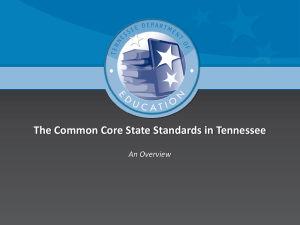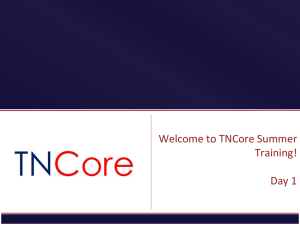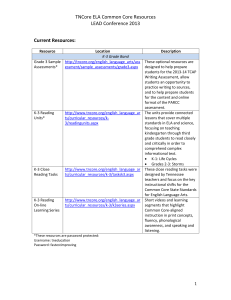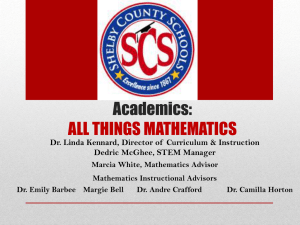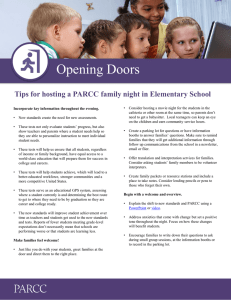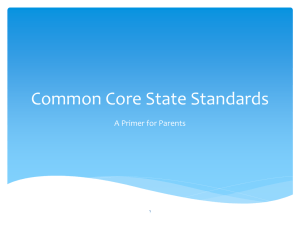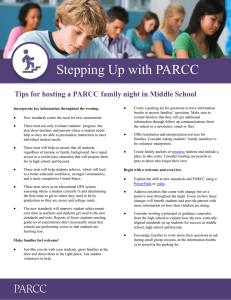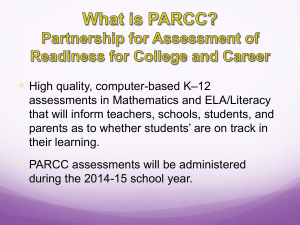Putting the Pieces Together Presentation PARTICIPANT VERSION
advertisement
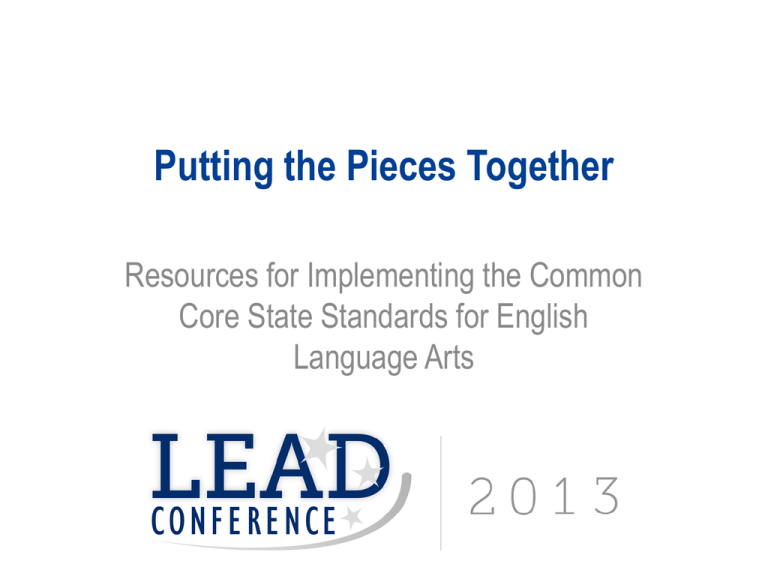
Putting the Pieces Together Resources for Implementing the Common Core State Standards for English Language Arts Objectives • Know the layout of state resources for building Common Core-aligned curriculum and instruction • Understand the ways these various resources can interact in a classroom • Experience sample resources as models of instruction • Begin a planning process for aligning district curriculum to the Common Core Today’s agenda • • • • • • • • Welcome and introduction Overview of K-3 ELA resources Overview of 4-12 ELA resources (Break #1) Walkthrough of sample K-3 resources Walkthrough of sample 4-12 resources (Break #2) Collaborative planning around next steps Three instructional shifts 1. Building knowledge through content-rich nonfiction 2. Reading, writing, and speaking grounded in evidence from text, both literary and informational 3. Regular practice with complex text and its academic language ELA/Literacy guidance documents • Released in May 2013 and posted to tncore.org: – K-12 ELA: http://www.tncore.org/english_language_arts/curricular_resources.aspx – 6-12 Literacy: http://tncore.org/literacy_in_social_studies/standards_and_shifts/focus_standar ds.aspx • Optional guidance to help districts incorporate the instructional shifts and turn over curriculum during this year’s transition to new standards • Implementing the instructional shifts and focusing on the following three priorities will provide students with the best preparation for PARCC assessments in 2014-15 and the TCAP Writing Assessment in 2013-14: 1. Stop teaching the dropped SPI’s 2. Prioritize readings of rich, complex text multiple times and for varying purposes 3. Give students sequenced, text-dependent questions and writing tasks that require them to cite evidence, simultaneously developing students’ reading, writing, speaking, listening, and thinking skills Overview of K-3 resources Grade 3 Sample Assessments: http://tncore.org/english_language_arts/assessment/samp le_assessments/2013-14sampleassessments.aspx K-3 Curricular Resources: http://www.tncore.org/english_language_arts/curricular_re sources/k-3.aspx – Reading units – Close reading tasks – On-line learning series Overview of 4-12 resources Grade 4-12 Sample Assessments: http://tncore.org/english_language_arts/assessment/samp le_assessments/2013-14sampleassessments.aspx 4-12 Curricular Resources: http://www.tncore.org/english_language_arts/curricular_re sources.aspx (click on appropriate grade band) – ELA units – Close reading tasks Where we are headed PARCC Model Content Frameworks Curriculum (district decision) *Textbook? District? Other? *Short texts (literary or informational) *Writing focus: opinion/argument or informational/explanatory Close read Close read Culminating writing assessment Unit 2 Unit 3 Unit 4 PARCC EOY *Extended text (literary or informational) PARCC PBA Module/unit 1 Where we are now PARCC Model Content Frameworks *Textbook? District? Other? *Extended text (literary or informational) TDOE Units (with close reads and *Short texts (literary or informational) culminating assessments) *Writing focus: opinion/argument or informational/explanatory Close reading Close read task Close read Writing Culminating tasks writing (instructional, assessment diagnostic, or benchmark) Unit 2 Unit 3 Unit 4 TCAP PARCC ACH/EOC EOY Module/unit 1 TCAP Writing PARCC Assessment PBA Curriculum (district decision) Grade 3: Putting the pieces together (example) Standards focus: • CCSS.ELA-Literacy.RI.3.3 Describe the relationship between a series of historical events, scientific ideas or concepts, or steps in technical procedures in a text, using language that pertains to time, sequence, and cause/effect. • CCSS.ELA-Literacy.W.3.2 Write informative/explanatory texts to examine a topic and convey ideas and information clearly. Grade 3 example: relevant resources • TCAP ELA Phase 1 Writing Task: Grade 3: http://tncore.org/english_language_arts/assessment /sample_assessments/grade3.aspx • Grades 2-3 Reading Unit: Storms: http://tncore.org/english_language_arts/curricular_r esources/k-3/readingunits.aspx • Grade 2-3 “Me First” Close Reading Task: http://tncore.org/english_language_arts/curricular_r esources/k-3/tasksk3.aspx Grade 3: Assessment of student learning sequence •Diagnostic: Close Reading Task •Formative: Reading Unit •Summative: TCAP Phase 1 Writing Task Grade 3 Inf/Exp Rubric Grade 3: Alignment with Model Content Frameworks and PARCC PARCC Grade 3 Sample Item http://www.parcconline.org/samples/english-languageartsliteracy/grade-3-elaliteracy • Main idea and details providing evidence from the text • Life cycle of a butterfly Grade 9-10: Putting the pieces together (example) • Essential question: How do speakers build effective arguments, and how can we make arguments about an argument’s effectiveness? (meta-argumentation) • Standards focus: – CCSS.ELA-Literacy.RI.9-10.8 Delineate and evaluate the argument and specific claims in a text, assessing whether the reasoning is valid and the evidence is relevant and sufficient; identify false statements and fallacious reasoning. – CCSS.ELA-Literacy.W.9-10.1 Write arguments to support claims in an analysis of substantive topics or texts, using valid reasoning and relevant and sufficient evidence. Grade 9-10 example: relevant resources • 9-10 Phase I writing task (coral reefs): http://tncore.org/english_language_arts/assessment /sample_assessments/grades9-10.aspx • 9-10 arguments and methods unit: http://tncore.org/english_language_arts/curricular_r esources/9-12/text_unit_9-12.aspx • 9-10 Antigone task: http://tncore.org/english_language_arts/curricular_r esources/9-12/tasks912.aspx Demonstration of 9-10 unit close reading task 1. Read King excerpt as an individual, annotating for: – – – – In margin: P (for hints of purpose) In margin: A (for hints of audience) Underline his key argument(s) Circle metaphors 2. Fill out graphic organizer as an individual (just first row) 3. With a partner, discuss your responses and select one to share out that you find the most compelling 4. Share out 9-10 unit task 1.4 9-10 Example: assessment of student learning sequence • Diagnostic: coral reefs task • Formative: revised Antigone prompt: – After reading and analyzing Ismene’s and Antigone’s argument in the prologue, write an essay in which you evaluate which sister makes the most compelling argument and why. Explain your evaluation using details from the text, focusing on each character’s rhetorical methods. • Summative: culminating assessment in arguments and methods unit • Rubrics can be found at http://tncore.org/english_language_arts/assessment/scoring_ resources/2013-14scoringresources.aspx 9-12 Argument Rubric Grades 9-10: Alignment with Model Content Frameworks and PARCC PARCC sample item: grade 7 RST http://www.parcconline.org/samples/english-languageartsliteracy/grade-7-elaliteracy You have read three texts describing Amelia Earhart. All three include the claim that Earhart was a brave, courageous person.[…] Consider the argument each author uses to demonstrate Earhart’s bravery. Write an essay that analyzes the strength of the arguments about Earhart’s bravery in at least two of the texts. Remember to use textual evidence to support your ideas. Collaborative planning 1. How might you use this resource? 2. What results might you expect from using this resource? 3. How will you communicate about this resource? Conclusion • Questions and answers • Contact info: – Mia Hyde Coordinator of Reading Content and Resources Tennessee Department of Education Mia.Hyde@tn.gov – Lior Klirs Coordinator of English Language Arts Content and Resources Tennessee Department of Education Lior.Klirs@tn.gov • Survey Thank you!
